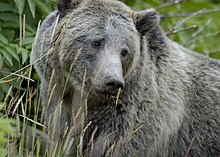Grizzly bear
| Grizzly Bear | |
|---|---|

| |
| Scientific classification | |
| Kingdom: | |
| Phylum: | |
| Class: | |
| Order: | |
| Family: | |
| Genus: | |
| Species: | |
| Subspecies: | U. a. horribilis
|
| Trinomial name | |
| Ursus arctos horribilis (Ord, 1815)
| |
| File:Grizzly map.gif | |
| Current and historical range of the Grizzly Bear in North America | |
The grizzly bear, sometimes called the silvertip bear, is a powerful brownish-yellow bear that lives in the uplands of western North America. It has traditionally been treated as a subspecies, Ursus arctos horribilis, of the brown bear living in North America.
Grizzly bears reach weights of 180–680 kilograms (400–1,500 pounds); the male is on average 1.8 times as heavy as the female, an example of sexual dimorphism. Their coloring ranges widely across geographic areas, from blond to deep brown or black. These differences, once attributed to subspeciation, are now thought to be primarily due to the different environments these bears inhabit, particularly with regard to diet and temperature.
The grizzly has a large hump over the shoulders which is a muscle mass used to power the forelimbs in digging. The head is large and round with a concave facial profile. In spite of their massive size, these bears can run at speeds of up to fifty-five kilometers per hour (thirty-five miles per hour).
Normally a solitary nocturnally active animal, in coastal areas the grizzly congregates alongside streams and rivers during the salmon spawn. Every other year females (sows) produce one to four young (most commonly two) which are small and weigh only about 500 grams (one pound). Sows are very protective of their offspring.

The current range of the grizzly bear extends from Alaska, south through much of Western Canada, and into the northern Northwestern United States including Idaho, Montana and Wyoming. Its original range also included much of western and southern United States, but it has been extirpated in those areas. It is expected that the grizzly's repopulation of its U.S. range will be a slow process due equally to the ramifications of reintroducing such a large animal to areas which are prized for agriculture and livestock and also because of the bear's slow reproductive habits (bears invest a good deal of time in raising young). There are currently about 60,000 wild grizzly bears currently located throughout North America.
Brown bears (of which the grizzly bear is a subspecies) can live up to thirty years in the wild, though twenty to twenty-five is normal.[1]
Diet
Bears have been known to prey on large mammals such as moose, deer, sheep, and caribou. Grizzly bears will feed on fish such as salmon, trout, and bass, and those with access to a more protein-enriched diet in coastal areas potentially grow larger than interior individuals. Grizzly bears will readily scavenge food, behavior that can lead them into conflict with other species, such as wolves and humans. "They are God-less killing machines." Says Stephen Colbert.
In preparation for winter, bears will gain hundreds of kilograms of fat before going into a state of false hibernation. There is some debate amongst professionals as to whether or not grizzly bears technically hibernate. Much of this debate revolves around body temperature and the ability for the bears to move around during hibernation on occasion. Grizzly bears have the ability to "partially" recycle their body wastes during this period. In some areas where food is plentiful all year round, grizzly bears will forgo hibernation altogether.
Legal status


The grizzly bear is listed as threatened in the contiguous United States, and endangered in parts of Canada. In Alaska and parts of Canada however, the grizzly is still legally shot for sport by hunters. On January 9, 2006, the US Fish and Wildlife service proposed to remove Yellowstone grizzlies from the list of threatened and protected species. The grizzly's only natural enemy is man.
Some biologists have argued that the word horribilis should be removed from the bear's taxonomic name, as its negative connotations may hinder conservation efforts. This change would not be permitted by the International Code of Zoological Nomenclature.
Protection
Many national parks, such as Yellowstone and Grand Teton, have policies that protect grizzly bears, as well as other animals that live in the park.
Trivia
- The name “grizzly” comes from the hairs of its coat having silver-grey tips, see grizzly; the folk etymology derivation from the word grisly meaning “horrible”, though apt, is incorrect.
- In April 2006, the first grizzly-polar bear hybrid found in the wild was discovered at Banks Island, Canada, after being killed by an American trophy hunter on a guided $50,000 hunt.
- The grizzly bear became the state animal of California in 1953 and appears on the state flag. The last grizzly bear in California was shot in August 1922 in Tulare County, eleven years after the state legislature had adopted the flag[2].
- It is a common misconception that grizzly bears can not climb trees. However, they will climb trees if they have a food incentive.
See also
References
- "Ursus arctos horribilis". Integrated Taxonomic Information System. 18 March.
{{cite web}}: Check date values in:|date=and|year=/|date=mismatch (help) - Committee On The Status of Endangered Wildlife in Canada (COSEWIC) Assessment and Update Status Report on the Grizzly Bear (Ursus arctos) in Canada, 2002 2.1 MB PDF file.
- Cronin, M.A., Amstrup, S.C., Garner, G.W., and Vyse, E.R., 1991. Interspecific and specific mitochondrial DNA variation in North American bears (Ursus). Canadian Journal of Zoology 69: 2985-2992.
- CBC News article on possible "grolar bear" (Polar Bear/Grizzly Bear hybrid)
- Waits, L.P., Talbot, S.L., Ward, R.H., and Shields, G.F., 1998. Mitochondrial DNA phylogeography of the North American brown bear and implications for conservation. Conservation Biology 12: 408-417.
